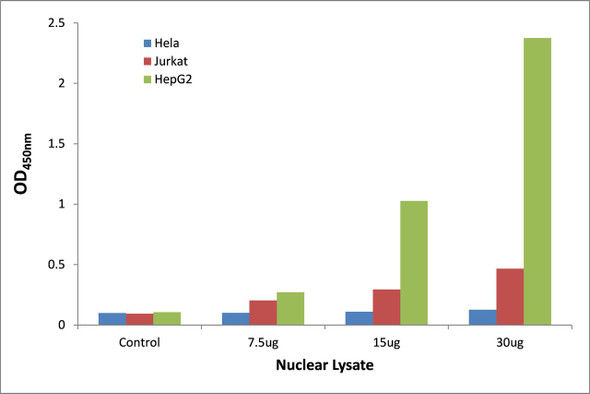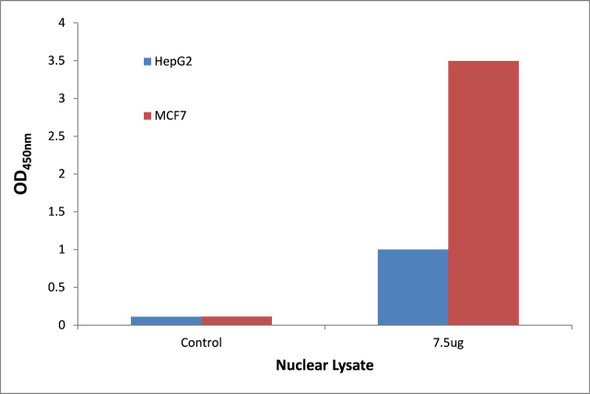Description
| Product Name: | SPI1 Transcription Factor Activity Assay |
| Product Code: | TFAB00102 |
| Target: | SPI1 |
| Reactivity: | Human, Mouse, Rat |
| Sample Types: | Nuclear or cell lysates |
The Assay Genie SPI1 transcription factor activity assay allows for the detection and qualitative analysis of endogenous levels of activated transcription factors in a variety of nuclear and cell lysates
Assay Genie ELISA kits are designed to significantly reduce experiment time and ensure sensitivity and flexibility for high-throughput screening.
| Assay Time: | 4.5 hours |
| Detection Method: | Colorimetric 450 nm |
| Size: | 12 x 8-Well Microstrips |
| Storage: | 4°C for 6 months |
| UniProt Protein Function: | PU.1: Binds to the PU-box, a purine-rich DNA sequence (5'- GAGGAA-3') that can act as a lymphoid-specific enhancer. This protein is a transcriptional activator that may be specifically involved in the differentiation or activation of macrophages or B- cells. Also binds RNA and may modulate pre-mRNA splicing. Binds DNA as a monomer. Interacts with CEBPD and NONO. Interacts with RUNX1 and SPIB. Interacts with GFI1; the interaction represses SPI1 transcriptional activity. Highly expressed in both FV-P and FV-A-induced erythro- leukemia cell lines that have undergone rearrangements of the Spi- 1 gene due to the insertion of SFFV. Belongs to the ETS family. 2 isoforms of the human protein are produced by alternative splicing. |
| UniProt Protein Details: | Protein type:DNA-binding; Transcription factor; Oncoprotein Chromosomal Location of Human Ortholog: 11p11.2 Cellular Component: nuclear chromatin Molecular Function:NFAT protein binding; protein binding; RNA binding; RNA polymerase II transcription factor activity, enhancer binding; transcription factor activity Biological Process: anatomical structure regression; cell differentiation; erythrocyte differentiation; granulocyte differentiation; lymphocyte differentiation; lymphoid progenitor cell differentiation; macrophage differentiation; myeloid dendritic cell differentiation; negative regulation of gene expression, epigenetic; negative regulation of MHC class II biosynthetic process; negative regulation of transcription from RNA polymerase II promoter; negative regulation of transcription, DNA-dependent; positive regulation of transcription from RNA polymerase II promoter; positive regulation of transcription, DNA-dependent; regulation of erythrocyte differentiation; somatic stem cell maintenance; transcription from RNA polymerase II promoter |
| NCBI Summary: | This gene encodes an ETS-domain transcription factor that activates gene expression during myeloid and B-lymphoid cell development. The nuclear protein binds to a purine-rich sequence known as the PU-box found near the promoters of target genes, and regulates their expression in coordination with other transcription factors and cofactors. The protein can also regulate alternative splicing of target genes. Multiple transcript variants encoding different isoforms have been found for this gene. [provided by RefSeq, Jul 2008] |
| UniProt Code: | P17947 |
| NCBI GenInfo Identifier: | 60415923 |
| NCBI Gene ID: | 6688 |
| NCBI Accession: | P17947.2 |
| UniProt Secondary Accession: | P17947,P17433, Q6BDS1, |
| UniProt Related Accession: | P17947 |
| Molecular Weight: | 31,211 Da |
| NCBI Full Name: | Transcription factor PU.1 |
| NCBI Synonym Full Names: | Spi-1 proto-oncogene |
| NCBI Official Symbol: | SPI1 |
| NCBI Official Synonym Symbols: | OF; PU.1; SFPI1; SPI-1; SPI-A |
| NCBI Protein Information: | transcription factor PU.1 |
| UniProt Protein Name: | Transcription factor PU.1 |
| UniProt Synonym Protein Names: | 31 kDa-transforming protein |
| Protein Family: | Transcription factor |
| UniProt Gene Name: | SPI1 |
| UniProt Entry Name: | SPI1_HUMAN |






